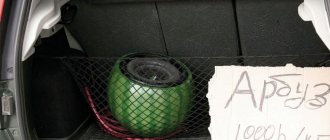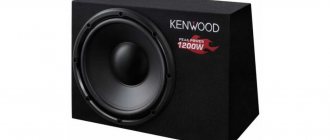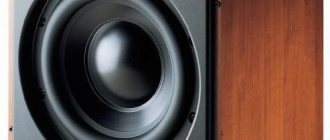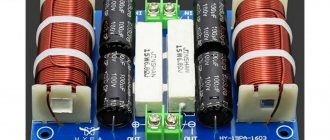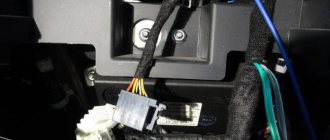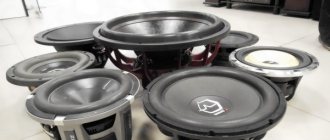Good day friends, today we will talk about assembling a small subwoofer, the subwoofer of which I have wanted to have in my car for so long but could not afford because I simply could not find a place for it. It's no secret that it is a low-frequency speaker that reproduces only a narrow frequency spectrum (usually 20-200Hz) that can truly improve the overall sound picture and provide rich bass. But not everything is as simple as I wanted, the fact is that the limiting factor for me was precisely the fact that under no circumstances did I want to sacrifice space in the trunk and the possibility of transforming it. Let me remind you that instead of the third row, I have an organizer in which I periodically put various small items. More details HERE
Buying a standard BOSE subwoofer for a spare seemed to me not a very good idea, but I didn’t reject the option of buying a ready-made flat subwoofer under the seat until the last minute. But again, not everything is so simple, it turned out that in my case it was almost impossible to find a flat sub of a suitable size, either the height was too large, or the width... in general, having scoured the entire Internet, I still couldn’t find the dimensions I needed, 350x160x170mm. (WxHxD)
The only way out was to assemble an active sub of the sizes I needed myself, but before that I ordered: —
low-frequency speaker 40W 4″ Here is
the LINK
The installation process took me a lot of time and effort, the fact is that the height of the body had to be made smaller so that nothing would prevent the driver’s seat from being easily adjusted “further or closer”, the difficulty was in installing the seat back …there was no turning back and with the help of a mat I managed to stick the chair into place, sacrificing five centimeters of adjustment (now the sub prevents me from moving closely on the sled to the steering wheel), but fortunately I don’t need this. However, the body would need to be made smaller in height.
I didn’t bother too much with the power supply, I connected the minus to the body near the handbrake, and took the plus from the cigarette lighter chip, pulled it to the fuse block, and especially not to the battery, because the consumption of the subwoofer at its peak is no more than 100W, which is about 8A (positive wire to the cigarette lighter 4mm sq. holds 40A and is protected by a 30A fuse), and I take into account the fact that at any voltage in the network at the amplifier input there will be exactly 24V, eliminating any drawdowns (I left the DC-DC converter only for this reason).
The chair fell perfectly into place and, what is also important, the subwoofer body did not eat up any useful space.
Foot room for passengers in the second row has not decreased at all.
Even with all the desire, you can’t reach the subwoofer with your feet.
What pleased me was that the power can be adjusted in the equalizer settings by changing the level of the output signal to the sub (amplifier), and there you can roughly adjust the gain or attenuation of the bass, midrange and treble
As a result of all the manipulations, we have some kind of subwoofer that does not have wild power and will not be able to pump your entire area... In this design, the bass is not super deep and, of course, it will not shatter glass, but it still gave the desired effect, mid and low frequencies are played more expressively, the overall picture has become much better and without having an ear for music it won’t be difficult to notice the difference... I think many will understand me. It was possible to place the sub exactly where it would definitely not disturb anyone and it would not need to be dismantled in case of transformation of the interior or when transporting an undersized one... The compromise of this solution was the need to shorten the plastic air duct and limited adjustment of the slide settings (with a lower body height there would not have been a problem ), it’s good that in my case this is not a problem.
In theory, installing a subwoofer in a car is not at all difficult. It is enough to choose a suitable model in terms of power and find a place for it. However, in practice it is not so simple. In particular, in sedan-type bodies, a sub placed in the trunk sounds very muffled. In a small cabin, a powerful low-frequency speaker makes the body assembly units vibrate.
For users who do not have special knowledge, an excellent option for obtaining low frequencies in the sound picture would be a subwoofer in the car under the seat. Such a device is easy to install, connect, and does not take up much space.
How it works
First of all, an under-seat subwoofer is a small device. It is manufactured with a minimum volume of air inside. The design features of the products are as follows:
- compact body, rectangular, low height;
- speakers used - 6 or 8 inches;
- the active subwoofer has special radiators for the power switches of the built-in amplifier, located on the side parts of the case;
- A compact subwoofer in a car under the seat can have adjustments for the cutoff frequency and phase shift.
Each manufacturer positions its low-frequency car sound emitter in a compact housing as the best option for placement under a seat. At the same time, neither the car nor the characteristics of the main acoustics are described, which make it possible to create good sound in the cabin.
Types and methods of installation
Active car subwoofer under the seat or passive in the trunk. This is the definition you need to start choosing from. Today there are two types of subs:
- Active:
includes a complete module in the form of a speaker, amplifier, crossover, and all this is clad in a durable aluminum case; - Passive:
This is essentially a speaker without a housing.
A striking example of an asset can be given in the form of Focal Integration IBus
. The model is the latest development of the famous brand, which can easily outshine the engineering solutions that are installed in the premium class. Technologies have made it possible to implement maximum capabilities and functionality in a minimum size.
Installing the device is actually as easy as shelling pears
, no special skills required. If difficulties arise, you can use the instruction manual. By default, the sub is equipped with ISO connectors for power wiring and RCA connectors for clear sound output.
With a height of only 7.0 cm, it easily fits under the space of all the seats. In addition, such a close location helps to save on cable pulling; you must admit, this is also not cheap. Therefore, owners have one less headache.
Rating
Each compact and fairly powerful subwoofer under a car seat, after a thorough analysis of consumer reviews, was included in the 2022 rating. Sales volumes of a particular product were also taken into account. For installation under a chair, you can buy both an active subwoofer and passive acoustics, provided you have a sufficiently powerful external amplifier.
A subwoofer is an element of an acoustic system that reproduces the sound of audio tracks at the lowest frequencies. Having a good subwoofer is a music lover’s dream, because everyone loves the high-quality sound of music inside the car. However, such a device is not cheap. However, most car owners can calculate the subwoofer box and make it themselves in order to avoid unnecessary expenses on a factory model.
Useful information to read
Locations for subwoofer installation
Car speakers (tweeters, mid-bass, mid-range speakers), due to their technical parameters and emitted frequencies, cannot provide full transmission of the lower part of bass timbres, low frequencies, and infrasound.
Music lovers and car audio fanatics believe that only a surround subwoofer in a bass reflex or horn box with specially designed acoustic parameters can produce full, clear and powerful sound. In recording, rehearsal acoustic studios, and concert halls, two subwoofers are installed frontally at the edges of the sound front. It is clear that such an installation of volumetric low-frequency speakers in the limited space of a car is impossible.
Professionals consider the best place to install one or two subwoofers to be the trunk of a car, in which, after installation, there is no space left to perform direct functions. For drivers who constantly transport cargo and family luggage, this method is not suitable. There is no room for a subwoofer in the trunks of convertibles and city hatchbacks. Even in large crossovers and SUVs, subwoofers take up almost the entire trunk volume.
In principle, a compact subwoofer can be installed on a shelf above the rear passenger seat (in sedans), in the armrests (between the rear seats), under the seats, but the quality of low-frequency sound transmission decreases. Installing a woofer on the rear window shelf of sedans is not aesthetically pleasing; if the balance is incorrectly adjusted, the woofer deafens the rear passengers.
Many car enthusiasts prefer installing a compact subwoofer under the driver or front passenger seat. Experienced specialists of the Auto Captain service will recommend you a real place to install a low-frequency speaker, but before that you need to know the type and make of the car, the model of the subwoofer. Many models have insufficient space under the rear seats; a tool box or luggage box may be located under the front passenger seat.
Selecting the type and model of subwoofer
In terms of playback quality, passive type subwoofers are considered the best. An external amplifier is matched to the woofer's power, making it easier to balance frequencies with other speakers in the car. A passive subwoofer is not suitable for installation under the seats, since there is no space left for mounting a separate external amplifier. Most models of compact subwoofers are of the active type (their own amplifier is built into the speaker housing).
How to choose speakers for your subwoofer
Subwoofers are used in cars to improve the sound of music at low frequencies. For regular listening to melodies or radio broadcasts, the standard audio system in the car is quite sufficient, but connoisseurs of loud and clear sound at low frequencies prefer to place a subwoofer in the cabin.
When selecting speakers for a future product, the car owner learns that they can be round or oval in shape and size. Typically (based on the dimensions of the car interior), round speakers with a diameter of 10, 13 or 16 cm, as well as oval speakers with a length of 15x23 cm are selected. Accordingly, the larger the diameter of the speaker, the better the sound will be reproduced at low frequencies.
How to Know Which Car Speakers Are Right for You
Before making a subwoofer for your car yourself, you need to clarify several basic points:
- The shape of the speakers does not affect the sound quality of music in the car;
- The depth and richness of the sound is affected only by the size of the speaker;
- You need to think carefully about the exact shape and size of the speakers so that the subwoofer looks appropriate in the cabin.
Design is not of paramount importance, so when choosing a speaker, its technical characteristics are a priority
Characteristics for good sound
- Power indicators from 75 to 150 W;
- Frequency 45-145 Hz;
- The amplifier outputs 110 and 55 W through two channels;
- Resistance indicator 4 ohms;
- The device is powered directly from the battery using a cable with a cross-section of at least 3.0 mm and a length of about 5.0 meters;
Some craftsmen manage to mount the device in the side wall of the trunk, although this is not surprising, and also in a drawer for small items, popularly known as an armrest (by the way, you can make it yourself).
The versatility of the device allows it to be installed in any car, even budget versions that require additional sound insulation. Because one of the requirements for successful sound quality is that the sound absorption is properly installed.
The first models of subs had a bad reputation for overheating and failed very often. New devices are equipped with protection in several stages, the so-called cascade protection, namely: overheating, short circuit, triggering an increase in current in the circuit. A fuse package closes this entire system, this is in case the cascade does not react.
Standard audio systems of domestic cars and budget foreign cars are not equipped with subwoofers (low-frequency speakers). In car acoustic tuning, calculating a bass reflex box for a subwoofer, its manufacture, and proper installation are among the most difficult types of work. Therefore, installing a subwoofer (as speakers are often called acoustics), as a rule, completes the tuning of the audio system. Professionals consider the trunk of the car to be the best place to install a surround woofer speaker in a car, but many car owners have reasons to look for another installation location. Another problem when installing a subwoofer may be the price of the device, the choice of speaker type and amplification method. For beginners in acoustic tuning who do not have high demands on the sound quality of a car audio system, installing a compact subwoofer under one of the car seats seems to be a good option.
When ordering the installation of a subwoofer in a specialized workshop of the Auto Captain service, you will receive qualified assistance in all aspects of choosing acoustic equipment, advice on choosing the location, type and model of the subwoofer. All equipment installation work will be carried out for you accurately by experienced craftsmen.
- Acura
- Alfa Romeo
- Audi
- Bentley
- BMW
- Cadillac
- Chevrolet
- Chrysler
- Citroen
- Daewoo
- DAF
- Datsun
- Dodge
- Fiat
- Ford
- Geely
- Great Wall
- Hino
- Honda
- Hummer
- Hyundai
- Infiniti
- ISUZU
- Porsche
- Renault
- Saab
- Scania
- SEAT
- Skoda
- Smart
- SsangYong
- Subaru
- Suzuki
- Toyota
- Volkswagen
- Volvo
- GAS
- ZIL
- KamAZ
- UAZ
Designing a homemade subwoofer
Car subwoofers are installed in the luggage compartment or on the rear parcel shelf, which is why this system is called rear.
The most important point in manufacturing is determining its size and design. Depending on the tasks assigned, the design can have a variety of variations.
Types of subwoofers
There are only two main types of subwoofers. If we talk about the relationship to an audio power amplifier, then they are conventionally divided into:
- active. They already have a built-in amplifier and crossover, which provide high sound quality and remove high frequencies from the sound. An active subwoofer receives signals from any source with which it has a connection;
- passive. The device is not equipped with additional amplification elements, so it is connected to the main audio system of the cabin. The only drawback of a passive subwoofer is that it seriously loads all the channels of the system, and therefore the sound quality decreases.
Active subwoofers do not load the standard cabin audio system, so they have better sound quality
Where to install: in the trunk or under the seat
If an active subwoofer can be placed almost anywhere, then the purity and power of its sound at low frequencies will directly depend on the location of the passive device. Depending on the preferences of the car owner and the availability of free space in different types of cars, several installation locations are offered:
- in the center in front is the optimal position for communication with the front speakers, which will ensure almost perfect sound of tracks in the cabin. However, most cars don't have room in the front to accommodate any large devices, so a center front location is more suitable for minibuses;
- in the trunk, with the speaker directed forward - one of the most popular ways to place a subwoofer among drivers. Suitable for all types of vehicles;
- in the trunk, with the speaker directed backwards - more suitable for a car in a hatchback body, since the sound wave does not encounter obstacles in its path. The location in the trunk back is unacceptable for cars in a sedan or coupe, since the sound will be greatly deformed due to the specific design of the luggage compartment;
- on the floor under the seat is another option, which, however, is not widely popular among drivers. Due to the fact that the subwoofer is located flush with the floor, and the housing is located under the seat, the sound encounters many obstacles in its path;
- on the rear parcel shelf is one of the best options for placing a subwoofer in all types of cars. The main condition is that the shelf must be wide and strong enough to withstand low-frequency bass.
Photo gallery: main places to place the device in a car
When choosing a location to install a subwoofer, you need to accurately calculate how safe the bass energy will be for surrounding objects. The fact is that resonance from the housing can, in some cases, damage both the installation site and the glass in the car.
Other benefits
All that the subwoofers we describe can do is provide front mid-bass. But the features of underseat subwoofers are not limited to this, so to speak, quantitative bass indicator. Here are some of their advantages I would like to dwell on in more detail:
- With seatposts, the problem of bass localization is significantly reduced;
- You can select emergency conditions within a wider range compared to traditional options, based on your own auditory sensations.
Note. Some subs of this type may not have a second high-pass filter.
- If we compare underseat subs with their “adult” counterparts, the former have one more advantage, which manifests itself in the best possible way in a cramped car interior. And the smaller the interior, the better the compact subwoofer will perform;
Active subwoofers under the seat
- In terms of box design, only ZYa is suitable for compact subs. For FI, the box will be too big, and there will be problems with the pipe;
- Underseat subs are always produced active, which is easy to explain, given the connection to the amplifier of a speaker of almost the same size. But the built-in amplifier is ideally suited for such conditions, and in most cases the pulsed version is used with all its inherent advantages: low energy consumption, small dimensions, heat dissipation, etc.;
- In terms of equipment, the seatposts are not much different from their counterparts. Well, only models without a bass regulator are quite common in this line. But this is easily explained: the “seat seat” is not a speaker that would need periodic boosting (and it won’t withstand it);
Active under-seat subwoofer outputs
- Let us note the high-level inputs of the “seat seats”, which are invariably present in any model;
- It is also considered normal for seatposts to have a remote control.
How to calculate hull displacement
What is the volume of the case? This is one of the main quantities on which the sound of the speakers in the subwoofer will directly depend. There are two ways to calculate the volume of the case: using professional programs or manually.
To calculate the volume of enclosures, you can use programs such as JBL SpeakerShop or Winisd beta. A special service modifier will not only allow you to determine the optimal dimensions and volume of the subwoofer specifically for your car, but will also add a 3D model of it for clarity.
In addition, the programs will calculate the dimensions of all parts and elements necessary for manufacturing, so you just have to take the derived parameters and make a box based on them.
How to calculate the volume of a case manually
Calculations without the use of specialized software are simpler, although it will be impossible to imagine the model of the future subwoofer or the dimensions of its housing.
The volume of the box is calculated using the formula V = h*L*A.
In this case, the following values must be substituted into the formula:
- h is the height of the box;
- L is the length of the box;
- A is its height.
Knowing all these parameters, it is easy to determine the volume of the subwoofer housing.
The program algorithm will take into account all your wishes and calculate the volume and other parameters of the case quickly and correctly
What to make a box from
A subwoofer box is more than just a box that houses a speaker. The box must comply with many dynamic laws of acoustics in order for the sound to be truly rich and clear. To make different types of boxes, different materials will be required, and the manufacturing methods will in many ways be different from one another.
How to build a box for a bass reflex subwoofer
The standard version of a homemade subwoofer is a bass reflex. This is the simplest type of subwoofer; moreover, its box is good because a special bass reflex tube allows you to reproduce low frequencies that are practically not perceived by the human ear. And the design of the box is quite simple, which makes its production accessible to almost everyone.
- sound insulation;
- wood screws 50 mm long;
- drill;
- screwdriver;
- electric jigsaw;
- liquid Nails;
- sealant;
- PVA glue;
- carpet
The housing for housing a bass reflex subwoofer must be as durable as possible and not allow sound waves to pass through. Multilayer plywood or high quality chipboard is perfect for these purposes. The best option is to take a plywood sheet 30 mm thick.
To make the case you need to follow this plan:
- Prepare parts of the body: front, back, two sides, bottom and top in accordance with your calculations or parameters derived by programs.
- To fit the speaker size (for example, diameter 160 mm), cut a hole in the front part of the housing blank.
- Above the hole for the speaker you will also need to cut a slot for the bass reflex tube and screw the bass reflex compartment to it.
- After two holes are made on the front panel, you need to glue all the side parts of the box together and then screw them to each other with self-tapping screws.
- In this case, it is especially important to tighten each screw until it stops, since empty spaces between the panels will seriously distort the sound of the speaker.
- Next, you will need to cut a small hole for the wires on the back of the case.
- Before connecting all parts of the case, we insert the speaker.
- Next, it is necessary to carry out the interior finishing of the case: for this, all joints and cracks need to be coated with resin or sealant to improve the sealing, after which soundproofing fabric is glued to all side panels.
- After completing the interior decoration, you need to move on to the exterior: the body is covered with carapet fabric, and the fabric should also cover the slot for the bass reflex. Karapet can be tensioned using regular epoxy or a furniture stapler.
Once the speaker is secured, wires are pulled from it through the hole and connected to the car's sound system.
Photo gallery: how to assemble a compact box with a bass reflex
How to make a Stealth subwoofer box with your own hands
Despite the sound quality of a bass-reflex subwoofer, not every driver wants to carry a large box in the trunk. In some cases, the luggage compartment must be filled with things and cargo, so there is no room left for a subwoofer.
The logical way out of the situation is to make a Stealth subwoofer for the trunk. It will provide the same low-frequency sound quality as a bass reflex, but will take up minimal space.
Usually the Stealth subwoofer is installed directly in the trunk, but there are often cases of installation inside the fender or even in the spare wheel well.
The minimum volume required for normal operation of the Stealth is 18 liters, provided that a 12-inch speaker is used.
Materials and tools
To make your own Stealth subwoofer, you need to prepare in advance:
- speaker grille;
- speaker;
- socket for connection;
- wires of the required length;
- plywood or chipboard 20 mm thick;
- a piece of fiberboard;
- epoxy glue;
- brush;
- fiberglass;
- masking tape;
- polyethylene;
- wood screws (40 mm);
- jigsaw;
- drill.
How to properly install and connect a subwoofer in a car
Installing a homemade device in a car, as well as connecting it, will require a certain tool. So, in addition to the fact that you need a subwoofer and an amplifier for it, you will have to worry about the following devices in advance:
- fuse;
- wires (three wires in one winding - for power, for “+” to the battery and a wire to the radio);
- capacitor;
- wire cutters;
- insulating tape;
- plastic clamps;
- set of wrenches.
Once a location has been chosen to install the subwoofer, you need to make sure that it will withstand the resonant waves coming from the device. Installing subwoofers on fragile and light vehicle surfaces is prohibited.
The wires are connected according to the following diagram:
- Initially, the subwoofer wire is routed to the amplifier.
- From the amplifying device, the wire is connected to the car radio.
- The “+” power cable must be protected from damage - for example, wrapped in corrugation.
- The fuse is placed on the same “+” wire at a minimum distance from the battery.
You can connect the subwoofer yourself, based on the parameters of this circuit
Before starting work, make sure that the vehicle battery is disconnected. This is a safety measure that will not only avoid damage to the speaker system, but can also preserve the health and performance of parts of the human body.
Video: connecting and setting up a subwoofer
Independent design, manufacture and connection of subwoofers in a car is available to almost every driver. The key to success will be both a competent calculation of the dimensions and volume of the product, and careful assembly of the case. At the same time, the car enthusiast can independently select the desired size of speakers in order to create in the cabin the low-frequency sound that suits him most.
Installation prices
Fault diagnostics 0 / 500–1500 rub. Selection of audio system components 5 min – 1 hour free Adjustment of acoustics (during installation) free
Installation under the seat
Installing a subwoofer under the seat 2-3 hours 3500–4500 rub. Installation (mounting) of a changer under the seat 2 hours 2500–3500 rub. Enlightening (alteration) of the seat back negotiable
Installation in other places
Installation of a subwoofer in the rear parcel shelf 1 day negotiable Installation of a subwoofer in the rear wing (Stealth) 2–4 hours 2500–4500 rub. Installing a subwoofer in the armrest (front, rear) 1-2 days 4000–6000 rub.
Our other services
Audio training from an hour from 1000 rubles. Installation (installation) of coaxial acoustics 2–4 hours from 1400 rub. Installation (installation) of broadband acoustics 2–4 hours from 1600 rub. Installation (installation) of two-component acoustics 2–5 hours from RUB 3,500. Installation (installation) of three-component acoustics 3–6 hours from 4500 rub. Installation (installation) of tweeters 1–4 hours from 1000 rub. Installation (installation) of radio tape recorders from 15 minutes from 500 rubles. Organization of linear RCA outputs from an hour from 1000 rubles. Installation of a sound amplifier from an hour from 1000 rubles. Installation (installation) of a CD/DVD/MD changer 2 hours from 2500 rub. Installation (installation) of the processor with configuration 4–6 hours 1500–4000 rub. Installation (installation) of antennas from 30 minutes from 800 rub. Production of podiums for acoustics from an hour from 1000 rubles. Manufacturing of subwoofer housing 1–7 days from RUB 3,000. Installation of a cooling fan is negotiable Installation of a crossover 1 hour 800–1200 rub. Installation of a capacitor (storage) 1 hour 600–1500 rub.
